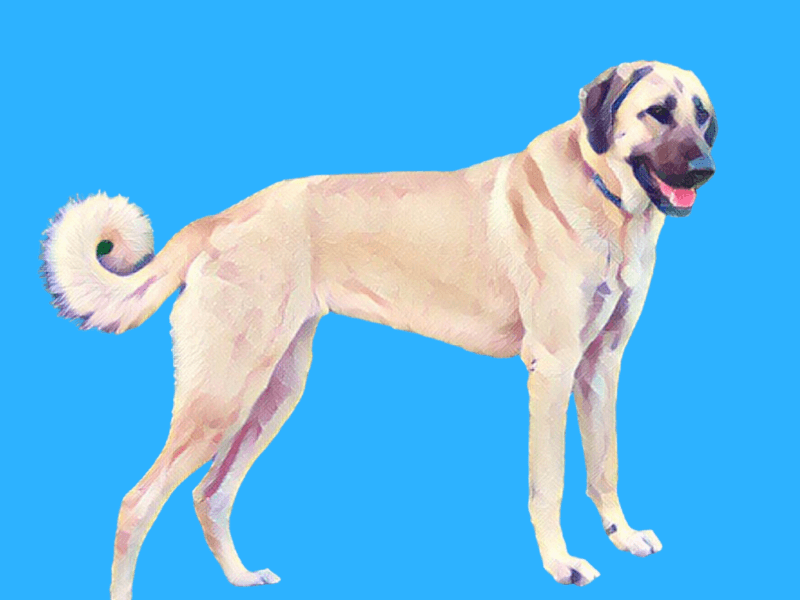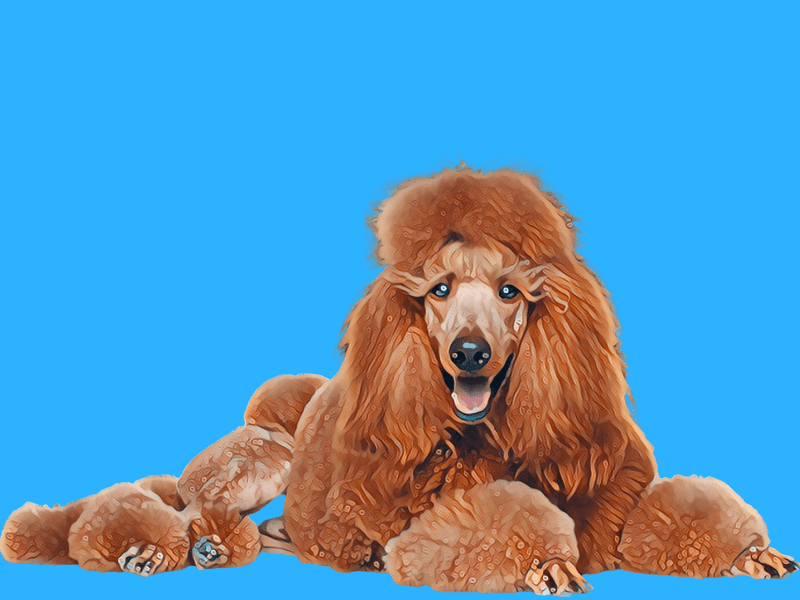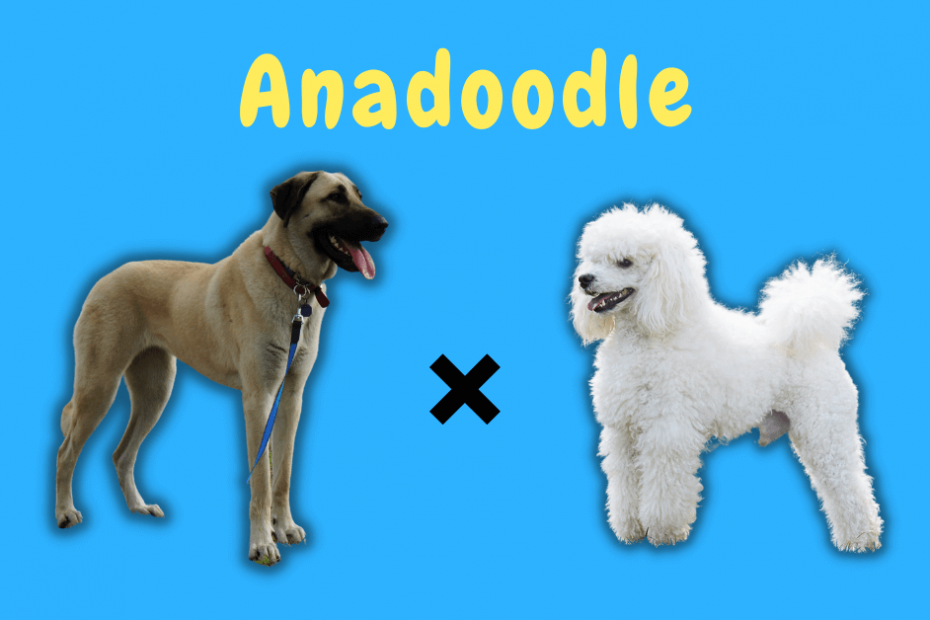The Anadoodle is a mix between an Anatolian Shepherd Dog and a standard Poodle.
This giant-sized Doodle breed is protective, easy to care for, and loving. They are nearly twice the size of your average Doodle dog, which is perfect for families looking for a strong and muscular watchdog.
This guide will walk through the history, temperament, appearance, and health of this unique Poodle mix.
Check it out!
What is an Anadoodle?

The Anadoodle, or Anatolian Shepadoodle, is a mix between an Anatolian Shepherd and a Poodle. Anatolian Shepherd Dogs are massive, so it is likely a mix between a standard-sized Poodle, the largest Poodle size.
It is possible through selective breeding or artificial insemination techniques to breed an Anatolian Shepherd Dog with a Miniature Poodle. Often seen in other Doodle breeds, this would create a Mini Anadoodle.
Other names
The Anatolian Shepherd Dog-Poodle mix can be called Anadoodle, Anatolian, Shepadoodle, Anatolian Doodle, Anatolian Shepdoodle, Anatolian Shepapoo, or Anatolian Shepherd Doodle.
It is not to be confused with the Shepadoodle (or German Shepadoodle), which is a German Shepherd-Poodle mix.
Origin
Mixed dog breeds never come with a clean history. It is hard to pinpoint exactly where or why these mixes took place. Purebred dogs often have a well-documented history.
This is not the case for the Anatolian Shepherd Dog-Poodle mix. The details on its history and origin are lacking. Luckily, its parent breeds have a record that spans hundreds of years in the past.
Let’s take a closer look!
History of the Parent Breeds
The Poodle and Anatolian Shepherd Dog both have an extensive history. Their origin story helps provide insight into the Anadoodle’s temperament and characteristics.
As a direct descendant, it inherits the traits that these dogs were initially bred for.
Anatolian Shepherd Dog

The Anatolian Shepherd Dog is of ancient lineage. These dogs originated in Turkey over 6,000 years ago as livestock guardian dogs.
The name ‘Anatolian’ comes from the Anatolia Peninsula in Western Asia (modern-day Turkey).
Amazingly well-preserved pieces of stone in the British Museum in London show carvings of large muscular dogs with heavy solid heads. These are believed to be relatives of the Anatolian Shepherd Dogs.
In the Book of Job, there are references to flocks that dogs accompanied. These, too, were likely relatives of the Anatolian Shepherd Dog.
This intriguing video takes a deep dive into the history and purpose of the Anatolian Shepherd Dog. It documents a California farmer’s life and reliance on the breed to protect his flock and his family.
[lyte id=’xCXKiGfdqhY’ /]
Modern Day Popularity
Anatolian Shepherd Dogs are currently found in Turkey and also in Afghanistan. In Turkey, they’re known as Çoban Kopegi (cho-bawn ko-pay), which translates to “Shepherd’s Dog” [1]asdca.club/breed.
These dogs are not herding dogs but rather genuine members of the flock, living their lives as constant companions to the sheep or goats and offering continuous protection. When livestock started becoming domesticated, these dogs changed from predators to protectors.
Shepherds use them in rural districts as the primary defense from predators for their livestock. Without the protection, these dogs offer, the Turkish shepherd’s animals would be at a greater risk of being taken by wild animals.
Some Turkish shepherds equip their dogs with deadly iron-spiked collars. This way, when an attacking predator grabs for the throat, it ends badly for the predator. The Anatolian Shepherd Dog is swift and agile and can usually run down a predator efficiently.
Anatolian Shepherd Dogs were brought to America in the 1950s [2]asdca.club/breed. When the Endangered Species Act was passed, people looked for ways to protect against predators without harming or killing them.
Usually, their significant physical presence within the flock or herd will keep predators away.
Poodle

Many people associate Poodles with France. However, these beautiful dogs originated in Germany. The name “Poodle” comes from “pudel,” a German word that means “to splash in” in English.
Poodles originated in Germany in the 1600s. They were bred to be hunting companions with exceptional skill in the water. They are highly trainable and athletic, which makes them perfect dogs to bring along on the hunt.
Poodles slowly migrated from the hunting grounds to people’s homes. Many Europeans, especially the French, took a liking to Poodles, and the breed began to spread across the continent.
Because of their high intelligence and athleticism, they became popular circus performers in France, leading to Miniature Poodles’ creation. Smaller Poodles were as intelligent as Standard Poodles but lighter, smaller, and easier to travel.
In the United States, the Mini Poodle was bred down in size to create the Toy Poodle. The purpose behind this selective breeding was to create a dog that would be a perfect companion for city dwellers.
Popularity
Today, Poodles are found in households all across the globe. They are often rated in the top 5 or top 10 most popular dog breeds by the American Kennel Club.
Appearance
The Anatolian Shepherd Dog-Poodle mix is a big dog with some serious power. The combination of the two breeds creates a sturdy and robust dog.
The Anatolian Shepherd Dog is a large size dog. They have smooth fur that’s typically a short length and grows in various colors. They usually have large muscles and are bulky in stature.
On the other hand, standard Poodles are medium-sized dogs. They have long, lean, and athletic bodies.
Size
The Anadoodle ranges in height from 15-29 inches, measured from the ground to the shoulder. This mix likely stands over 2 feet tall!
Have I mentioned the Anatolian Shepherd is a big dog? Females measure 27” from ground to shoulder height [3]www.akc.org/dog-breeds/anatolian-shepherd-dog. Males measure a whopping 29” from base to shoulder [4]www.akc.org/dog-breeds/anatolian-shepherd-dog.
Standard Poodles stand over 15 inches tall when measured from the ground to shoulder [5]www.akc.org/dog-breeds/poodle-standard. This is a decent height but nowhere near the Anatolian Shepherd.
Weight
The Anadoodle weighs between 50-150 pounds.
This is an extensive range in weight, but many factors influence the final adult weight. Gender, generation (F1, F2, etc.), sire or dam selection, and lifestyle all have an effect.
Female Anatolian Shepherd Dogs weigh between 80-120 pounds [6]www.akc.org/dog-breeds/anatolian-shepherd-dog. Male Anatolian Shepherd Dogs weigh in a little more at 110-150 pounds [7]www.akc.org/dog-breeds/anatolian-shepherd-dog.
Standard Poodles typically range in weight from 40-70 pounds. Female Poodles tend to weigh around the lower end of the range. Fully-grown male Poodles hover around 60+ pounds.
If the litter’s sire (or father) is a purebred Anatolian Shepherd, then the dogs will likely end up being much heavier than if a purebred Poodle was the sire. The same goes for generation.
An F1 Anadoodle would be different in size than an F2 Anadoodle since the parent breeds and ancestry would differ slightly.
The best way to determine how big your Anatolian Shepadoodle will grow is by using the parents’ size as an estimate.
Coat Colors
There is a vast array of coat colors and markings that an Anatolian Shepadoodle can have. This extensive color palette is due to both parent breeds.
Anatolian Shepherd Dogs have beautiful fur that ranges from blue fawn colors (blue fawn is a muted light brown color) to white and biscuit colors (biscuit color is a light brownish yellow color).
They can also have “brindle” fur, which typically appears as a rough striped pattern, alternating between light and dark fur colors.
Poodles have several possible coat colors, such as red, silver, white, brown, black, and more.
Combining both parent breed’s color profiles, the Anatolian Shepadoodle can take on the following coat colors:
- Apricot
- Biscuit
- Black
- Blue
- Blue Fawn
- Brindle
- Brown (or Chocolate)
- Café-au-lait
- Cream
- Fawn
- Gray
- Grey Fawn
- Liver
- Red
- Red Fawn
- Silver
- White
- Yellow
They can be mono-colored or a mix of colors, such as parti. There is also the potential they can have a merle coat.
Coat Type
The coat of the Anatolian Shepherd Dog-Poodle mix will depend on the parents. The chances are high. It will be wavy and curly, and medium in length.
Anatolian Shepherd Dogs have smooth fur that is generally short in length. They require minimal grooming… a good brushing a few times per month will do.
Poodles have a long, curly coats. It requires frequent brushing and grooming to avoid tangles and mats.
Anatolian Shepherd Dogs shed while Poodles do not. This means your Anatolian Shepadoodle will not necessarily be heavy shedding, but you’ll notice their fur gathering in places throughout the house.
Are they hypoallergenic?
No dog is truly hypoallergenic, but some are more hypoallergenic than others. The Poodle is a low-shedding, low-dander breed. This is great for someone who suffers from allergies.
Dogs are often mixed with Poodles because they can take advantage of their hypoallergenic coat. The Anadoodle will be relatively low-shedding and not likely aggravate owners’ allergies.
Traits and Characteristics
The following infographic summarizes the traits and characteristics of the Anatolian Shepherd Dog-Poodle mix.

Temperament
The Anatolian Shepadoodle inherits a perfect blend of personality traits from his parents.
They are moderately good with children and somewhat playful. They’re reserved when it comes to meeting strangers.
They need a fair amount of mental stimulation to keep the peace throughout the day.
Being strong-willed dogs, they’re on the harder side to train.
The Anatolian Shepherd Dog-Poodle mix is not an affectionate lap dog. They are very protective and caring for their family but do not show their care through affection.
They protect whatever they consider being in their pack… the kids, livestock, and even other family pets!
Energy Level
Anatolian Shepadoodles have a medium level of energy. They benefit from daily play, exercise, and jobs but don’t require constant planned activities. Mental stimulation needs to be added to the mix as well.
Health
Anatolian Shepadoodles are overall a pretty healthy breed. They are at risk of inheriting a few different health issues common to their parent breeds.
Common Health Issues
Based on the breed history of both parents, the health issues and diseases to be aware of are:
- Luxating Patella
- Epilepsy
- Skin Tumors (Squamous Cell Carcinoma)
- Bladder Stones
- Legg-Calve-Perthes Disease
- Hip Dysplasia
- Bloat
- Cushing’s Disease (Hyperadrenocorticism)
- Tracheal Collapse
- Sebaceous Adenitis
- Progressive Retinal Atrophy (PRA)
- Addison’s Disease
- Thyroid Problems (Hypothyroid & Hyperthyroid)
A good breeder will ensure the parents are screened for any of these issues before they are used for breeding.
These dogs can potentially be sensitive to anesthesia. Owners should ensure their vet is aware before proceeding with any medical procedures.
They should have yearly checkups at the vet, be current on their shots, have their ears checked regularly for signs of infection, and have their teeth brushed often.
Life Expectancy
Average life expectancy of an Anatolian Shepherd Dog-Poodle mix is 11-18 years.
Conclusion
The Anadoodle makes an excellent companion, especially if you have a “flock” to protect.
With their loving (although not super-affectionate) nature and attentive intelligence, these gigantic Doodle dogs would make a terrific addition to your family!
If you’re curious about other types of Doodle breeds, big or small, check out my all-encompassing guide to Doodle dogs.
FAQs
Are Anadoodles good with young children?
This breed is good with children and is VERY protective in nature. They’re not affectionate, cuddly, and playful, but they like to be part of a pack and will protect young children in their pack.
Where can I buy an Anadoodle puppy?
Currently, there is only one Anadoodle breeder in the United States: Rockin’ Diamond.


